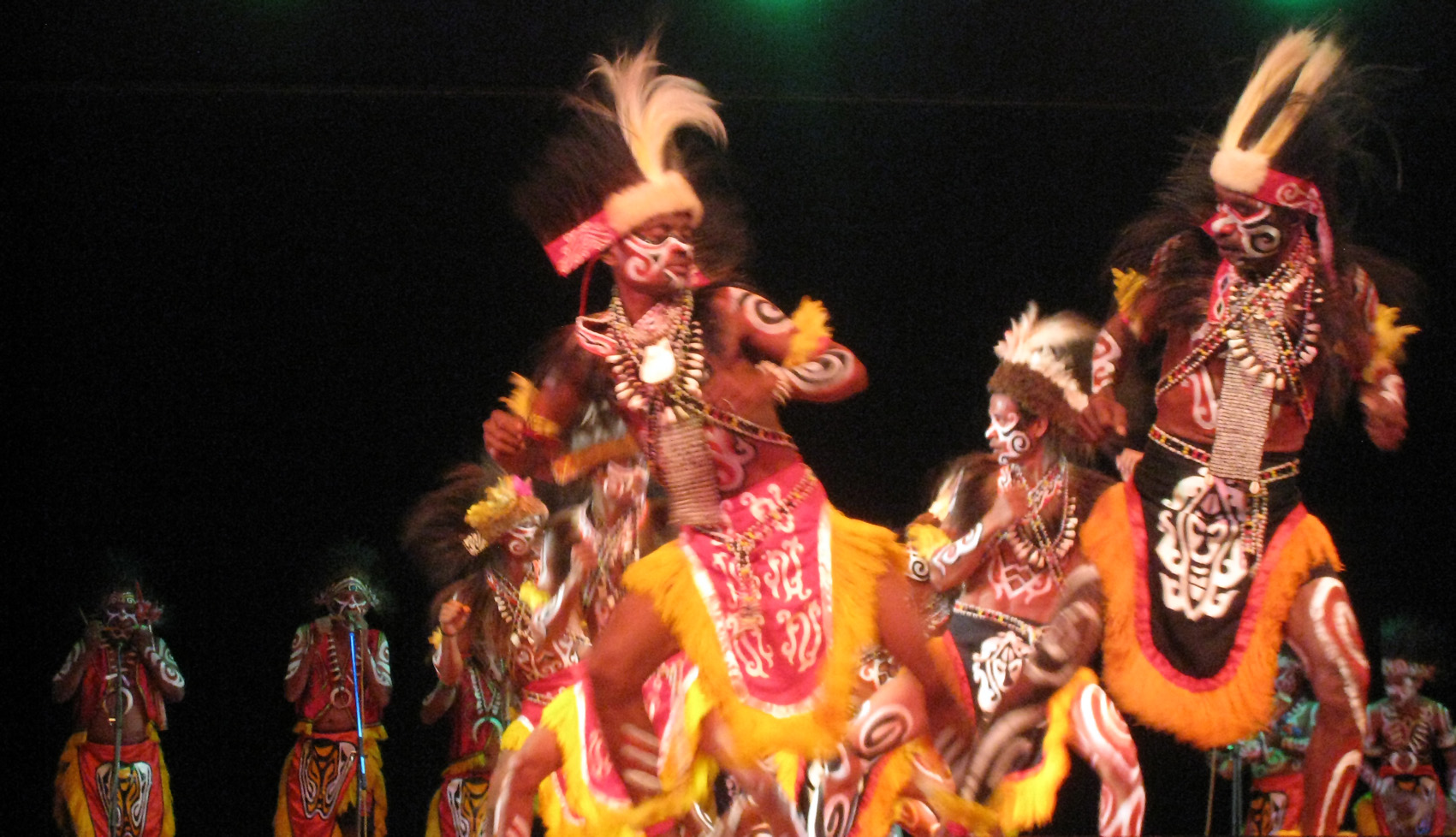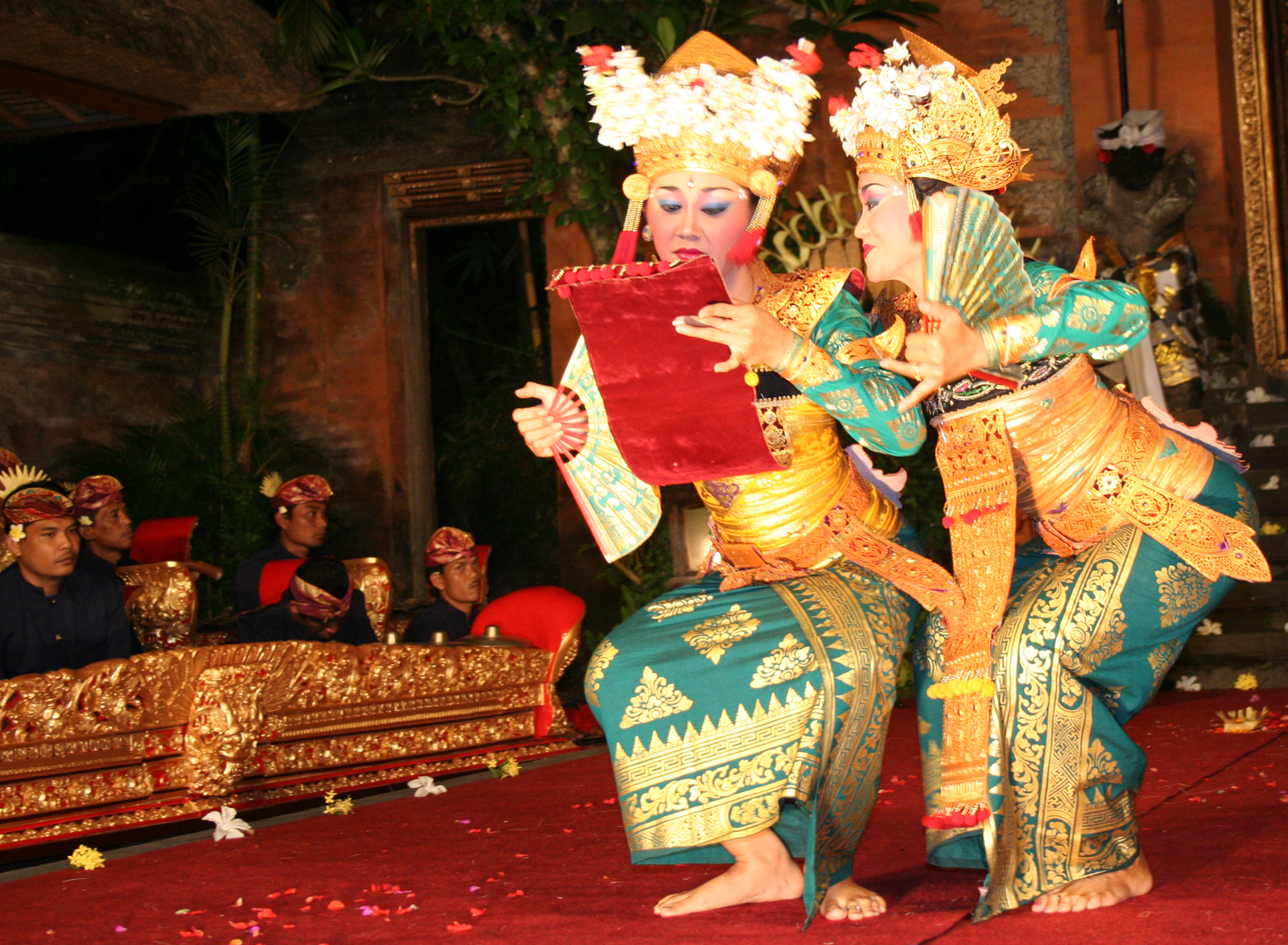|
Baris (dance)
''Baris'' dance ( ban, ᬩᬭᬶᬲ᭄) is a family of traditional war dances in Bali, Indonesia, accompanied by gamelan, in which dancers depict the feelings of a young warrior prior to battle, glorify the manhood of the triumphant Balinese warrior, and display the sublimity of his commanding presence. ''Baris'' derives its name from the word ''bebarisan'', which literally means "line" or "file formation", referring to the soldiers who served the ancient rajas of Bali. Performance There are two main types of ''baris'' dance which can be found throughout the island of Bali. The non-ritual dance is performed by a solo male dancer, and is often the first dance that a budding dancer learns. However, there are over thirty different types of ritual ''baris'' dances, each of which is performed by a group of people, still imitating the movements of the warrior. ''Baris tunggal'' A ''baris tunggal'' dancer, namely a ''baris'' dancer who performs on his own, is dressed in white leggings ... [...More Info...] [...Related Items...] OR: [Wikipedia] [Google] [Baidu] |
War Dance
A war dance is a dance involving mock combat, usually in reference to tribal warrior societies where such dances were performed as a ritual connected with endemic warfare. Martial arts in various cultures can be performed in dance-like settings for various reasons, such as for evoking ferocity in preparation for battle or showing off skill in a more stylized manner. It could also be for celebration of valor and conquest. Many such martial arts incorporate music, especially strong percussive rhythms. War dances Examples of war dances include: :* Aduk-Aduk – Brunei :* Ardah – Arabian Peninsula, Kuwait :* Ayyalah – Arabian Peninsula :* Baris – Bali, Indonesia :* Bende War Dance – Nigeria :* Buza – Russia :* Blood walk – Bloods of United States :*Cakalele – Maluku, Indonesia :*Capoeira, as well as some similar Afro-Caribbean arts :* Cibi – Fiji :*Crip Walk – Crips of United States :*Dirk dance and Scottish sword dances – Scotland :* European sword danc ... [...More Info...] [...Related Items...] OR: [Wikipedia] [Google] [Baidu] |
Kecak
''Kecak'' (pronounced ("kechak"), alternate spellings: ''kechak'' and ''ketjak''), known in Indonesian as ''tari kecakilolahhe'', is a form of Balinese Hindu dance and music drama that was developed in the 1930s in Bali, Indonesia. Since its creation, it has been performed primarily by men, with the first women's ''kecak'' group having started in 2006. The dance is based on the story of the ''Ramayana'' and is traditionally performed in temples and villages across Bali. Also known as the Ramayana monkey chant, the dance is performed by a circle of as many as 150 performers wearing checked cloths around their waists, percussively chanting "''chak''" and moving their hands and arms. The performance depicts a battle from the ''Ramayana'', in which the monkey-like Vanaras, led by Hanuman, help Prince Rama fight the evil King Ravana. ''Kecak'' has roots in ''sanghyang,'' a trance-inducing exorcism dance. History ''Kecak'' was originally a trance ritual accompanied by a male chor ... [...More Info...] [...Related Items...] OR: [Wikipedia] [Google] [Baidu] |
Balinese Dance
Balinese dance ( id, Tarian Bali; ban, ᬇᬕᬾᬮᬦ᭄ᬩᬮᬶ) is an ancient dance tradition that is part of the religious and artistic expression among the Balinese people of Bali island, Indonesia. Balinese dance is dynamic, angular and intensely expressive. Balinese dancers express the stories of dance-drama through the bodily gestures including gestures of fingers, hands, head and eyes. There is a great richness of dance forms and styles in Bali; and particularly notable are those ritualistic dance dramas which involve Rangda, the witch, and the great beast Barong. Most of the dances in Bali are connected to Hindu or traditional folk rituals, such as the Sanghyang Dedari sacred dance that invoke benevolent hyang spirits, believed to possess the dancers in a trance state during the performance. Other Balinese dances are not linked to religious rituals and are created for certain occasions or purposes, such as the Baris or Pendet welcoming dances and Joged dance, ... [...More Info...] [...Related Items...] OR: [Wikipedia] [Google] [Baidu] |
Gambuh
''Gambuh'' ( ban, ᬕᬫ᭄ᬩᬸᬄ) is an ancient form of Balinese dance-drama. It is accompanied by musicians in a gamelan ''gambuh'' ensemble. History ''Gambuh'' is one of the oldest surviving forms in Balinese performing arts, dating to the late Majapahit era (ca. 15th century) with very little known change since this time. Emiko Susilo writes, "when the dance-dramas of Majapahit came to Bali, they had the new task of ''preserving'' the tradition of a fallen dynasty" (emphasis in original). It also introduced a new element of narrative to Balinese performing arts that influenced other forms of dance-drama on the island, such as ''topeng'' masked dance and '' arja'' opera. For centuries it was supported by patronage at the royal courts of Bali's aristocracy, during which it achieved its greatest heights of sophistication. As the courts fell apart in the bloody wars with the Dutch, this support evaporated and much of the art of ''gambuh'' was lost. Like the many othe ... [...More Info...] [...Related Items...] OR: [Wikipedia] [Google] [Baidu] |
Herman Neubronner Van Der Tuuk
Herman Neubronner van der Tuuk (23 February 1824 – 17 August 1894) was a Bible translator and linguist specialising in the languages of the Dutch East Indies. Early years and studies Van der Tuuk was born in Malacca (part of the Dutch East Indies at that time), where his father, a Dutch lawyer, had settled and had married a half German and half Dutch Eurasian wife named Louisa. Her surname being Neubronner, it was added as a middle name to “Herman”. In 1825, the Treaty of London (1824) took effect, and Malacca became British in exchange for Bengkulu (a region in Sumatra). As a consequence, the Van der Tuuk family moved to Surabaya on the Isle of Java. At the age of about twelve, Van der Tuuk was sent to the Netherlands, where he attended grammar school and in 1840, aged sixteen, took the entrance exam to Groningen University. He read law, but his interests were in the field of linguistics, and in 1845 he moved to Leiden University to read Arabic and Persian with Th.W. ... [...More Info...] [...Related Items...] OR: [Wikipedia] [Google] [Baidu] |
Kris
The kris, or ''keris'' in the Indonesian language, is an asymmetrical dagger with distinctive blade-patterning achieved through alternating laminations of iron and nickelous iron (''pamor''). Of Javanese origin, the kris is famous for its distinctive wavy blade, although many have straight blades as well, and is one of the weapons commonly used in the '' pencak silat'' martial art native to Indonesia. A kris can be divided into three parts: blade ( or ), hilt (), and sheath (). Each part of the kris is considered a piece of art, often carved in meticulous detail and made from various materials: metal, precious or rare types of wood, or gold or ivory. A kris's aesthetic value covers the (the form and design of the blade, with around 60 variants), the (the pattern of metal alloy decoration on the blade, with around 250 variants), and referring to the age and origin of a kris. Depending on the quality and historical value of the kris, it can fetch thousands of dollars or more. ... [...More Info...] [...Related Items...] OR: [Wikipedia] [Google] [Baidu] |
KITLV 4396 - Isidore Van Kinsbergen - Bald Head Dancers (baris Demang) Of Boeleleng At Singaraja - 1865-1866
The Royal Netherlands Institute of Southeast Asian and Caribbean Studies ( nl, Koninklijk Instituut voor Taal-, Land- en Volkenkunde, lit = Royal Institute for the Linguistics, Geography and Ethnology, abbreviated: KITLV) at Leiden was founded in 1851. Its objective is the advancement of the study of the anthropology, linguistics, social sciences, and history of Southeast Asia, the Pacific Area, and the Caribbean. Special emphasis is laid on the former Dutch colonies of the Dutch East Indies (now Indonesia), Suriname, and the Dutch West Indies (the Netherlands Antilles and Aruba). Its unique collection of books, manuscripts, prints and photographs attracts visiting scholars from all over the world. On July 1, 2014, the management of the collection was taken over by Leiden University Libraries. Jakarta In 1969, a KITLV office was started by Hans Ras in Jakarta ("KITLV-Jakarta"), as a part of an agreement with the Indonesian Institute of Sciences. Here, publications from Indones ... [...More Info...] [...Related Items...] OR: [Wikipedia] [Google] [Baidu] |
Keris
The kris, or ''keris'' in the Indonesian language, is an asymmetrical dagger with distinctive blade-patterning achieved through alternating laminations of iron and nickelous iron (''pamor''). Of Javanese origin, the kris is famous for its distinctive wavy blade, although many have straight blades as well, and is one of the weapons commonly used in the '' pencak silat'' martial art native to Indonesia. A kris can be divided into three parts: blade ( or ), hilt (), and sheath (). Each part of the kris is considered a piece of art, often carved in meticulous detail and made from various materials: metal, precious or rare types of wood, or gold or ivory. A kris's aesthetic value covers the (the form and design of the blade, with around 60 variants), the (the pattern of metal alloy decoration on the blade, with around 250 variants), and referring to the age and origin of a kris. Depending on the quality and historical value of the kris, it can fetch thousands of dollars or more. ... [...More Info...] [...Related Items...] OR: [Wikipedia] [Google] [Baidu] |
Raja
''Raja'' (; from , IAST ') is a royal title used for South Asian monarchs. The title is equivalent to king or princely ruler in South Asia and Southeast Asia. The title has a long history in South Asia and Southeast Asia, being attested from the Rigveda, where a ' is a ruler, see for example the ', the "Battle of Ten Kings". Raja-ruled Indian states While most of the Indian salute states (those granted a gun salute by the British Crown) were ruled by a Maharaja (or variation; some promoted from an earlier Raja- or equivalent style), even exclusively from 13 guns up, a number had Rajas: ; Hereditary salutes of 11-guns : * the Raja of Pindrawal * the Raja of Morni * the Raja of Rajouri * the Raja of Ali Rajpur * the Raja of Bilaspur * the Raja of Chamba * the Raja of Faridkot * the Raja of Jhabua * the Raja of Mandi * the Raja of Manipur * the Raja of Narsinghgarh * the Raja of Pudukkottai * the Raja of Rajgarh * the Raja of Sangli * the Raja of Sailana * the Raj ... [...More Info...] [...Related Items...] OR: [Wikipedia] [Google] [Baidu] |
Gamelan
Gamelan () ( jv, ꦒꦩꦼꦭꦤ꧀, su, ᮌᮙᮨᮜᮔ᮪, ban, ᬕᬫᭂᬮᬦ᭄) is the traditional ensemble music of the Javanese, Sundanese, and Balinese peoples of Indonesia, made up predominantly of percussive instruments. The most common instruments used are metallophones played by mallets and a set of hand-played drums called '' kendhang/Kendang'', which register the beat. The kemanak (a banana-shaped idiophone) and gangsa (another metallophone) are commonly used gamelan instruments in Bali. Other instruments include xylophones, bamboo flutes, a bowed instrument called a ''rebab'', a zither-like instrument ''siter'' (in Javanese ensemble) and vocalists named '' sindhen'' (female) or ''gerong'' (male).Sumarsam (1998)''Introduction to Javanese Gamelan'' Middletown. Although the popularity of gamelan has declined since the introduction of pop music, gamelan is still commonly played in many traditional ceremonies and other modern activities in Indonesia, b ... [...More Info...] [...Related Items...] OR: [Wikipedia] [Google] [Baidu] |
Bali
Bali () is a province of Indonesia and the westernmost of the Lesser Sunda Islands. East of Java and west of Lombok, the province includes the island of Bali and a few smaller neighbouring islands, notably Nusa Penida, Nusa Lembongan, and Nusa Ceningan to the southeast. The provincial capital, Denpasar, is the most populous city in the Lesser Sunda Islands and the second-largest, after Makassar, in Eastern Indonesia. The upland town of Ubud in Greater Denpasar is considered Bali's cultural centre. The province is Indonesia's main tourist destination, with a significant rise in tourism since the 1980s. Tourism-related business makes up 80% of its economy. Bali is the only Hindu-majority province in Indonesia, with 86.9% of the population adhering to Balinese Hinduism. It is renowned for its highly developed arts, including traditional and modern dance, sculpture, painting, leather, metalworking, and music. The Indonesian International Film Festival is held every year in Bal ... [...More Info...] [...Related Items...] OR: [Wikipedia] [Google] [Baidu] |







